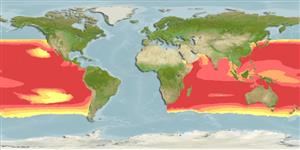Environment: milieu / climate zone / depth range / distribution range
Ökologie
seewasser; ozeanodrom (Ref. 51243); tiefenbereich 0 - 1830 m (Ref. 86942), usually 0 - 350 m (Ref. 89423). Subtropical; 43°N - 56°S, 20°E - 68°W
Indian and Pacific: tropical and temperate waters. Although some stray individuals are found in the Atlantic Ocean, this species is believed to have its spawning grounds and principal populations only in the Pacific and Indian Oceans. Highly migratory species.
Size / Gewicht / Alter
Maturity: Lm ? range ? - ? cm
Max length : 230 cm TL Männchen/unbestimmt; (Ref. 9308); common length : 190 cm TL Männchen/unbestimmt; (Ref. 9308); max. veröff. Gewicht: 52.0 kg (Ref. 43)
Rückenflossenstacheln (insgesamt): 0; Rückenflossenweichstrahlen (insgesamt): 51-57; Afterflossenstacheln 0; Afterflossenweichstrahlen: 18 - 23. Dark blue above, blue splattered with brown on the sides, silvery white below; 1st dorsal fin plain dark blue, other fins brown or dark brown; anal fin bases with tinges of silvery white.
Oceanic and epipelagic, found above the thermocline (Ref. 9308). Feeds on fishes, cephalopods and crustaceans. Also caught as a by-catch of long lines with hooks intended for tuna. Marketed frozen and prepared as fish cakes and sashimi in Japan (Ref. 9308). Also prepared as sausages.
Life cycle and mating behavior
Geschlechtsreife | Fortpflanzung | Ablaichen | Eier | Fecundity | Larven
Spawning is believed to occur mainly during the winter months, especially in warm offshore currents with surface temperature of about 25°C.
Nakamura, I., 1985. FAO species catalogue. Vol. 5. Billfishes of the world. An annotated and illustrated catalogue of marlins, sailfishes, spearfishes and swordfishes known to date. FAO Fish. Synop. 125(5):65p. Rome: FAO. (Ref. 43)
IUCN Rote Liste Status (Ref. 130435)
Bedrohung für Menschen
Harmless
Nutzung durch Menschen
Fischereien: weniger kommerziell; Sportfisch: ja
Mehr Information
ReferenzenAquakulturAquakultur ProfilZuchtlinienGenetikElectrophoresesVererbbarkeitKrankheitenVerarbeitungNutrientsMass conversion
Tools
Zusatzinformationen
Download XML
Internet Quellen
Estimates based on models
Preferred temperature (Ref.
123201): 13.9 - 28.8, mean 26.2 °C (based on 5116 cells).
Phylogenetic diversity index (Ref.
82804): PD
50 = 0.5630 [Uniqueness, from 0.5 = low to 2.0 = high].
Bayesian length-weight: a=0.00457 (0.00227 - 0.00920), b=3.21 (3.03 - 3.39), in cm total length, based on LWR estimates for this species & (Sub)family-body (Ref.
93245).
Trophic level (Ref.
69278): 4.5 ±0.76 se; based on food items.
Widerstandsfähigkeit (Ref.
120179): mittel, Verdopplung der Population dauert 1,4 - 4,4 Jahre. (Assuming tm=2-4).
Fishing Vulnerability (Ref.
59153): Very high vulnerability (90 of 100).
Climate Vulnerability (Ref.
125649): Moderate vulnerability (45 of 100).
Nutrients (Ref.
124155): Calcium = 35.6 [15.9, 65.1] mg/100g; Iron = 1.07 [0.56, 2.01] mg/100g; Protein = 19.6 [18.3, 20.8] %; Omega3 = 0.296 [0.155, 0.612] g/100g; Selenium = 69.5 [32.9, 148.9] μg/100g; VitaminA = 5.16 [1.47, 18.59] μg/100g; Zinc = 0.345 [0.222, 0.536] mg/100g (wet weight);
